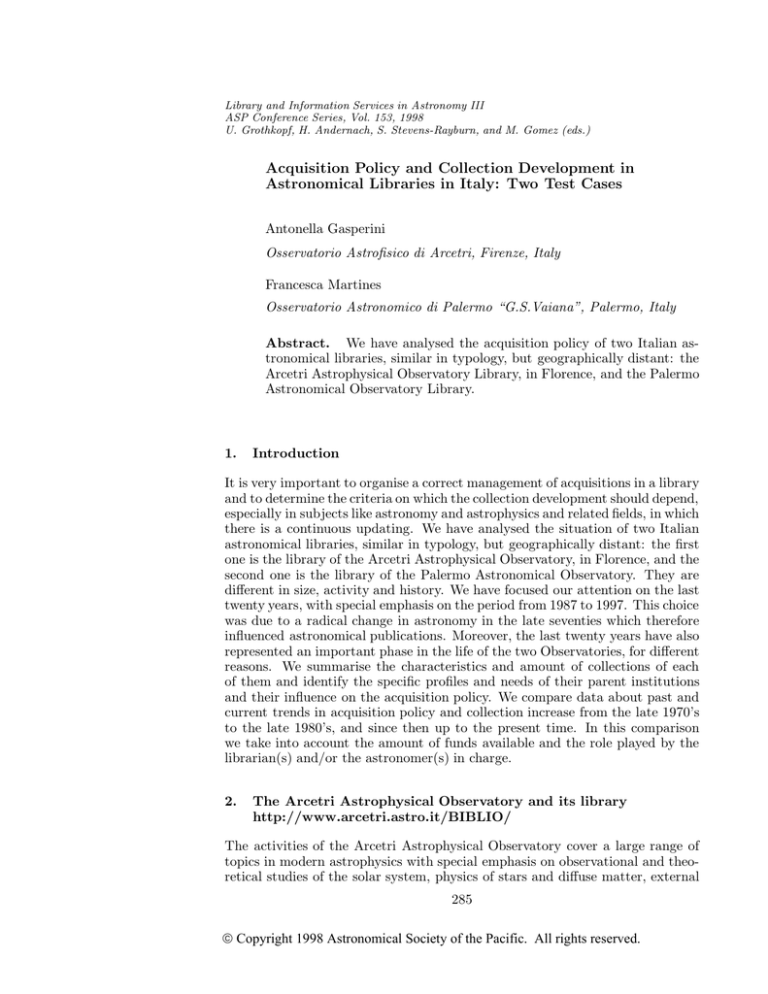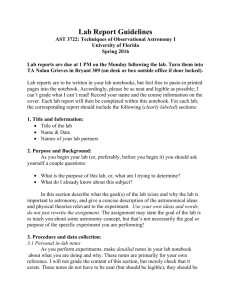
Library and Information Services in Astronomy III
ASP Conference Series, Vol. 153, 1998
U. Grothkopf, H. Andernach, S. Stevens-Rayburn, and M. Gomez (eds.)
Acquisition Policy and Collection Development in
Astronomical Libraries in Italy: Two Test Cases
Antonella Gasperini
Osservatorio Astrofisico di Arcetri, Firenze, Italy
Francesca Martines
Osservatorio Astronomico di Palermo “G.S.Vaiana”, Palermo, Italy
Abstract. We have analysed the acquisition policy of two Italian astronomical libraries, similar in typology, but geographically distant: the
Arcetri Astrophysical Observatory Library, in Florence, and the Palermo
Astronomical Observatory Library.
1.
Introduction
It is very important to organise a correct management of acquisitions in a library
and to determine the criteria on which the collection development should depend,
especially in subjects like astronomy and astrophysics and related fields, in which
there is a continuous updating. We have analysed the situation of two Italian
astronomical libraries, similar in typology, but geographically distant: the first
one is the library of the Arcetri Astrophysical Observatory, in Florence, and the
second one is the library of the Palermo Astronomical Observatory. They are
different in size, activity and history. We have focused our attention on the last
twenty years, with special emphasis on the period from 1987 to 1997. This choice
was due to a radical change in astronomy in the late seventies which therefore
influenced astronomical publications. Moreover, the last twenty years have also
represented an important phase in the life of the two Observatories, for different
reasons. We summarise the characteristics and amount of collections of each
of them and identify the specific profiles and needs of their parent institutions
and their influence on the acquisition policy. We compare data about past and
current trends in acquisition policy and collection increase from the late 1970’s
to the late 1980’s, and since then up to the present time. In this comparison
we take into account the amount of funds available and the role played by the
librarian(s) and/or the astronomer(s) in charge.
2.
The Arcetri Astrophysical Observatory and its library
http://www.arcetri.astro.it/BIBLIO/
The activities of the Arcetri Astrophysical Observatory cover a large range of
topics in modern astrophysics with special emphasis on observational and theoretical studies of the solar system, physics of stars and diffuse matter, external
285
Copyright 1998 Astronomical Society of the Pacific. All rights reserved.
286
A. Gasperini and F. Martines
galaxies and high energy astrophysics.
An intense effort is taking place on ground-based astronomical techniques in the
framework of national or international programs such as the Large Binocular
Telescope (LBT), the Galileo project, the Tirgo telescope, the Themis solar telescope, as well as in the on-going radioastronomical and adaptive optics programs.
The Arcetri astronomers, in collaboration with the Department of Astronomy
and Space Science of the University of Florence, also teach and are supervisors
of “laurea” and PhD theses. The staff includes about 120 people, of which about
50 are astronomers. Moreover, educational activities for school pupils and the
general public are regularly carried out. The large spectrum of activities going on at the Observatory is reflected in the library collection, that covers all
fields of astronomy. The library collection includes: about 10,000 monographs;
206 serial titles (112 current); 630 titles of Publications/Newsletters of Astronomical Observatories and Institutions; 30 items and collections of CD-ROMs,
including the Digitized Sky Survey; 15 links to on-line journals from the library
Web page. The major subject areas represented in the library are the following: Astronomy and Astrophysics (3,900), Physics (1,300), Mathematics and
Statistics (750), Computer Science (310), History of Science (especially history
of astronomy) (700), Geophysics (260), Astronomical Instrumentation (300),
Amateur/Popular/Educational Astronomy (300).
The library regularly receives preprints from about 75 Italian and international astronomical institutions.
The Arcetri historical collection was given in commodatum to the Library
of the Institute and Museum of the History of Science of Florence.
3.
The Palermo Astronomical Observatory and its library
http://www.astropa.unipa.it/Library/index.html
Today, the Palermo Astronomical Observatory “G.S. Vaiana” is a highly specialised institute, whose main interest is X-ray astronomy, with emphasis on the
study of the Sun and stars. Related interests include laboratory astrophysics
for the testing and calibration of space-borne instrumentation as well as high
resolution optical spectroscopy. Some activity is also going on in the history of
astronomy, particularly the history of science in Southern Italy.
The Observatory staff works in close cooperation with researchers of the Department of Physics and Astronomy of the University of Palermo. The staff includes
about 30 people, of which one third are astronomers.
Teaching activities are carried out in collaboration with the University of Palermo.
An educational activity for school pupils and the general public is also done regularly.
The specialised profile of the institution has influenced, of course, the nature of the library. In fact, until a few years ago, the subjects more represented
in the library were X-ray astronomy, the Sun and stars. This situation is now
gradually changing to cover all fields of astronomy. The library collection includes about 8,000 monographs, of which about 4,000 are modern; 400 serial
titles, including journals, newsletters and serial observatory publications, both
modern and old (68 current journals); 37 links to on-line journals and newsletters from the library Web page.
Acquisition Policy and Collection Development
287
The major subject areas represented in the library are the following (only modern books): Astronomy and Astrophysics (2,200), Physics (with special attention to Magnetohydrodynamics and Plasma Physics) (300), Mathematics
and Statistics (300), Computer Science (170), History of Science (400), Amateur/Popular/Educational Astronomy (300).
The library regularly receives preprints from about 30 Italian and international
astronomical institutions. The Palermo historical collection is still largely mixed
with the modern one, with not well-defined boundaries.
4.
Trends in acquisition policy at Arcetri
In 1978, when Franco Pacini became Director, the Arcetri Observatory was already a well-established institution, with an international reputation in the field
of Solar Physics. The new Director gradually increased the fields of research
at Arcetri, which now span from the solar system to extragalactic astronomy.
Also the library had already an extensive collection of physics, mathematics and
astronomy books, as well as subscriptions to the major scientific journals and a
large collection of observatory serial publications.
With regard to selection criteria, the collaboration of the librarian with an astronomer in charge proved to be a good filter between the needs of the users and
the organic development of the collections. This has been the standard policy
at Arcetri in the past ten years. Over the past decade the growth of the library
collection has developed steadily. The budget increase is mainly due to the
rise of the subscription charges of the journals (unfavourable exchange, rise in
prices, plus-charge for on-line versions). Apart from a peak in the years 1991-92
(which almost doubled the number of books purchased per year), there has been
a significant decrease of the number of the acquired monographs in the last few
years, while the number of journal subscriptions has remained substantially the
same.
5.
Trends in acquisition policy in Palermo
In 1976, when Giuseppe Vaiana became Director of the Observatory, the institution was in a marginal position in the scientific world, with very few research
funds and only one aged astronomer. Vaiana gave a new impulse to the life of
the institution and began the formation of a modern library.
Library expenses in the first decade since 1977 show a significant increase,
especially after 1980. The collection increase of about 1,200 books from 1977
to 1987 is not negligible if one considers that every year about 200 astronomy
books, relevant for professional researchers, are published. Also subscriptions to
the most important astronomical journals became more regular.
Regarding the selection criteria, the acquisitions were determined by specific
requests and needs of local researchers, and there was no scientist in charge or
professional librarian to select information resources. Most of the purchased
books were related to the subject areas of X-ray astronomy, the Sun and stars;
radioastronomy, extragalactic astronomy and cosmology were scarcely covered in
these years. Anyway, an effort was made by buying reference books in astronomy
and physics.
288
A. Gasperini and F. Martines
In 1988, but in practice only in 1990, the Observatory ceased to be a branch
of the Palermo University and became an autonomous research institute. This
also implied the possibility of employing professional librarians and to have more
funds for the library. With regard to the acquisitions, the trend was highly
variable from 1991 to 1995, and since then it has become more regular, with a
constant increase. The strong fluctuations in the Palermo trends before 1995
were at least partially due to the random nature of library fundings and to the
lack of an established acquisition policy.
More than 2,400 books have been purchased in the last decade but it is to
be noted that half of them has been acquired in the last three years. This is
essentially because of the following factors:
a) a substantial increase of the library budget
b) a more rational organisation of acquisitions, with an astronomer in charge
working in close cooperation with the librarian
c) the policy of covering subject areas not necessarily of strict interest to local
researchers.
6.
Conclusions
The acquisition trends discussed above reflect the different characteristics and
past histories of the two institutions. The regular trends of the Arcetri library
are due to its long tradition and well-established nature. The balance between
different science areas reflects the broad range of interests at the Observatory.
On the contrary, the more erratic behaviour of the Palermo library reflects the
past difficulties of the institution and the ongoing efforts to overcome them.
The situation is now rapidly changing as shown by the steep increase in the
acquisition trends in the last few years. This increase is mainly due to the
purchase of astronomy books (mostly published since 1990) to fill gaps in the
collection and broaden the subject areas covered. The next step will be to
extend a similar policy to the fields of Physics and Mathematics, i.e., areas that
are now less represented in the Palermo library. Similarly, an increase is expected
in expenses for journal back issues, to complete the existing collections. Another
issue that needs to be taken into account when comparing Arcetri and Palermo
is the absence of a historical collection in the former library, while modern and
old publications are still mixed in Palermo. A proper comparison will be possible
only when the boundary between historical and modern collections in Palermo
will be specified more clearly and/or when the Arcetri and Palermo collections
will be compared also in terms of publication date.







